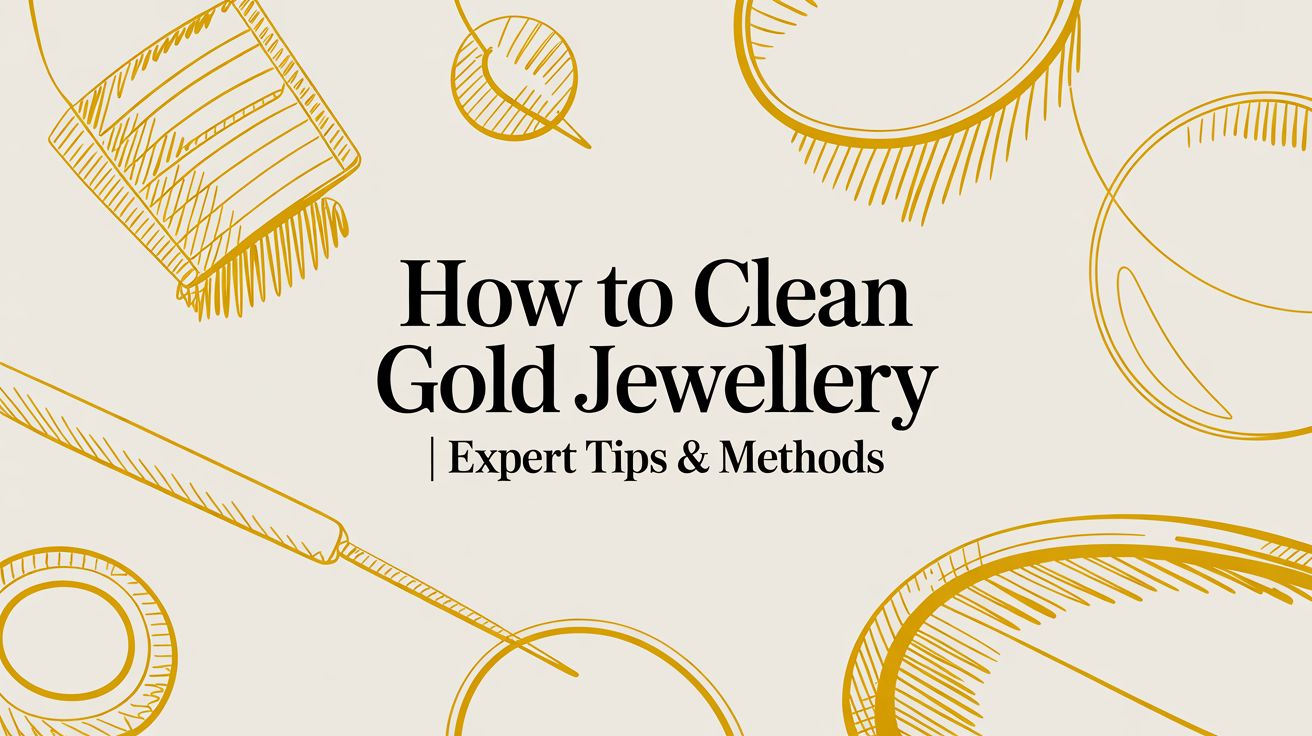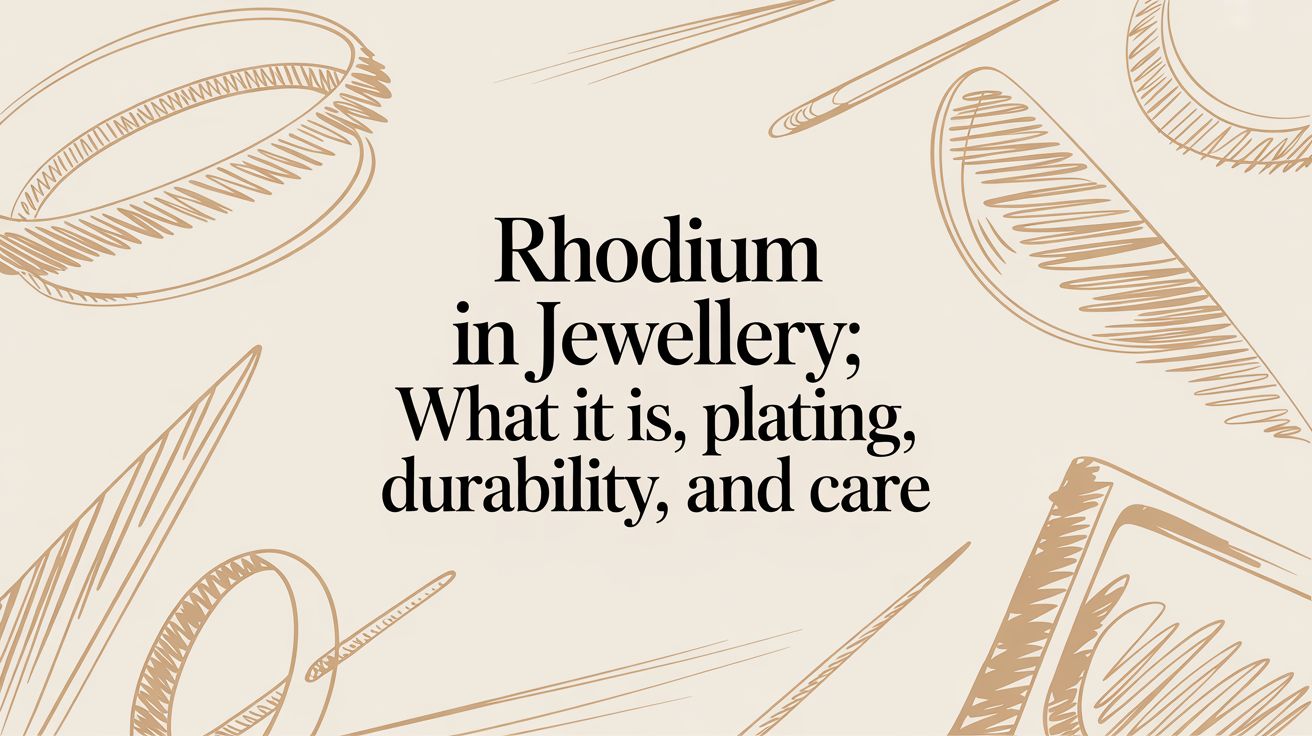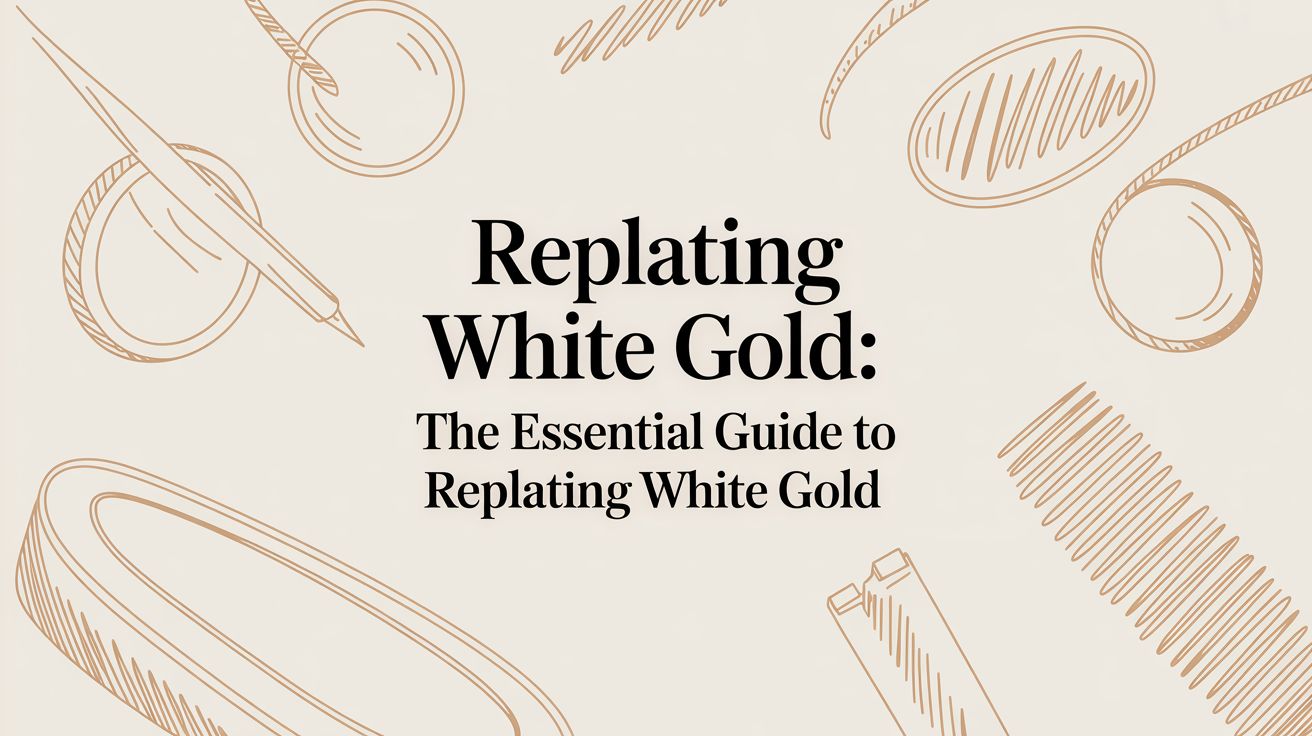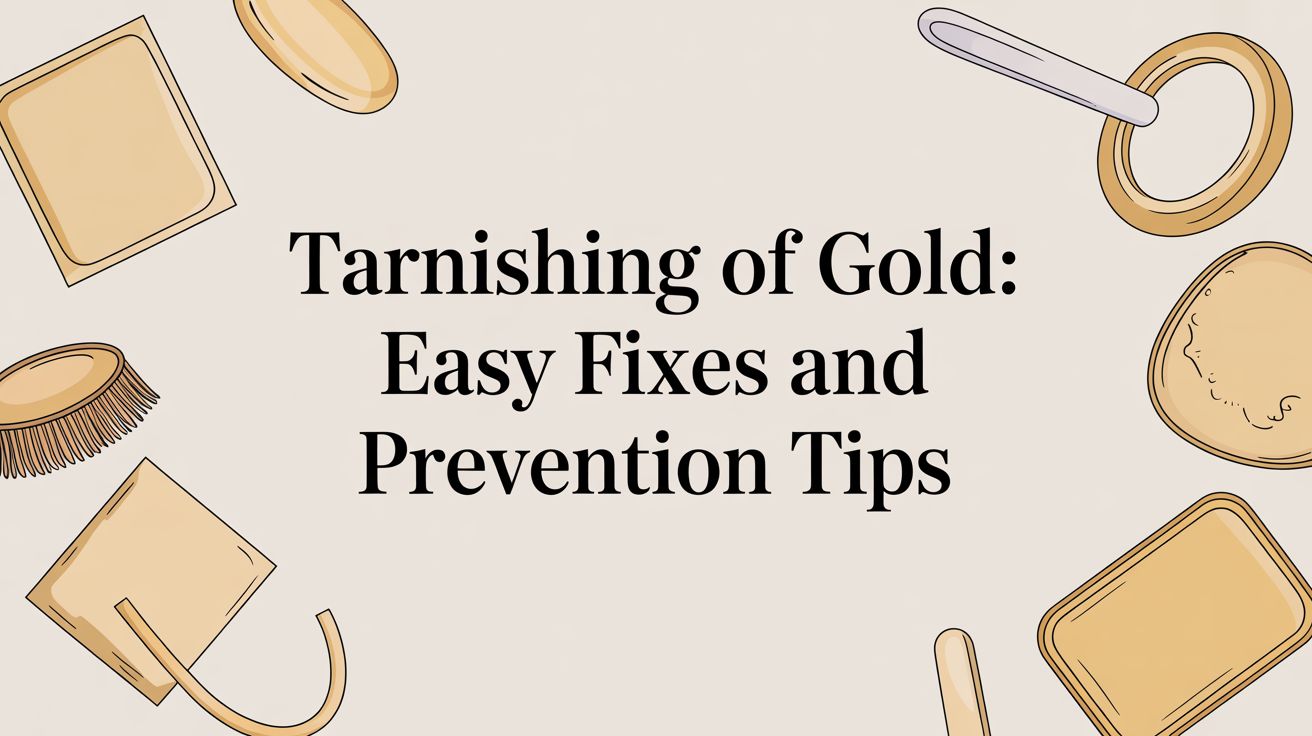Learning how to clean gold jewellery is actually quite simple. The best method I've found over the years involves a gentle soak in warm water with a few drops of mild washing-up liquid, followed by a careful scrub with a very soft-bristled brush. It's a straightforward, at-home technique that safely gets rid of the daily build-up dulling your favourite pieces, bringing back their natural shine without any harsh chemicals.
Why Your Gold Jewellery Looks Dull
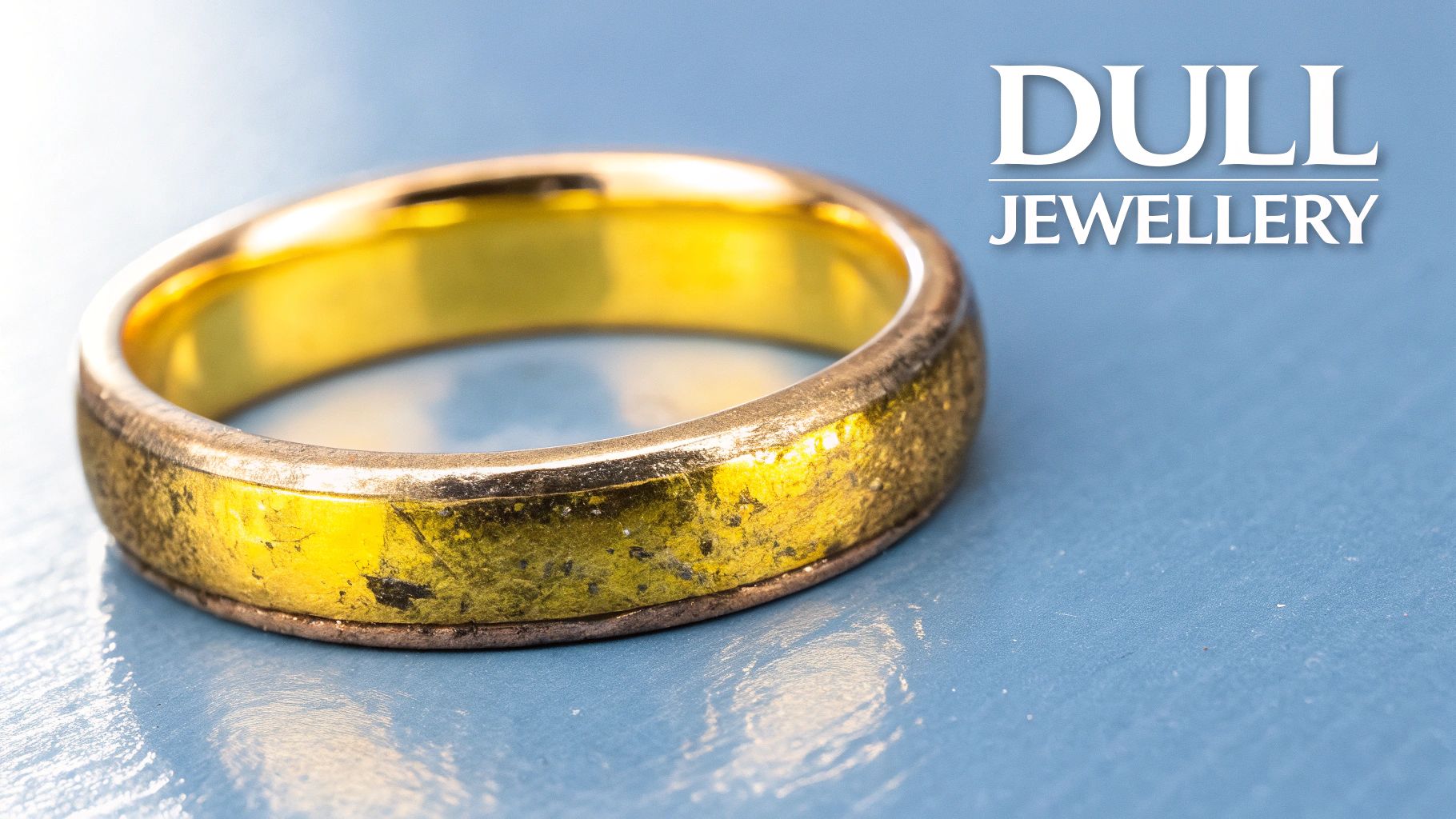
Ever looked at a favourite gold ring or necklace and wondered where its sparkle has gone? The culprit is usually just the accumulation of everyday life. Over time, a subtle, invisible film builds up, dimming the metal’s beautiful lustre. It’s entirely normal, but understanding what causes it is the first step to bringing back that showroom shine.
The main issue is contact with common substances. Just think about your daily routine: lotions, hand sanitisers, perfumes, and even the natural oils from your skin all transfer onto your jewellery. These residues create a slightly sticky surface that then traps dust and microscopic debris, forming a cloudy layer that stops light from reflecting properly off the gold.
Environmental and Lifestyle Factors
Beyond personal products, your environment plays a big part too. Here in many parts of the UK, the hard water from our taps contains minerals like calcium and magnesium. When you wash your hands or shower with your jewellery on, these minerals can leave behind a chalky residue that’s tough to notice at first, but builds up.
Even the air can be a factor. Pollutants and humidity can react with the other metals mixed with the gold (especially in 9k or 14k pieces), which can speed up tarnishing and discolouration.
This build-up isn’t just an aesthetic problem; it can also become a breeding ground for bacteria. That's why regular cleaning is essential not just for looks, but for hygiene too—particularly for items you wear all the time, like wedding bands or everyday earrings.
"For pieces worn daily, a film of oils and grime can develop in just a few weeks. This layer not only dulls the gold but can also irritate the skin underneath if left unchecked."
The Importance of a Cleaning Routine
Despite this, it's a simple maintenance task that many people overlook. You might be surprised at just how common this is. A 2023 survey of 2,000 UK residents found that approximately 66% of Brits never clean their jewellery. Only a tiny fraction, just 8% of people, clean their pieces at the six-month interval we'd recommend. You can read more about these jewellery care habits to see how you compare.
Getting into a consistent cleaning schedule prevents that severe build-up, making each clean quicker and far more effective. It turns jewellery care from a chore into a satisfying little ritual that protects your investment and keeps your treasured items looking as beautiful as the day you first wore them.
The Easiest At-Home Cleaning Method
For most gold jewellery, the best cleaning method doesn't involve expensive solutions or fancy gadgets. In fact, you probably have everything you need in your kitchen right now. This simple, safe technique uses nothing more than warm water and a little mild washing-up liquid to gently lift away the build-up of daily grime and oils.
It’s the same method professional jewellers often recommend for routine upkeep. Why? Because it’s incredibly gentle on the metal but surprisingly effective at bringing back that original, brilliant shine. The secret is getting the details right—from the water temperature to the type of brush you use.
This infographic gives you a quick visual rundown of the simple tools you'll need for this easy process.
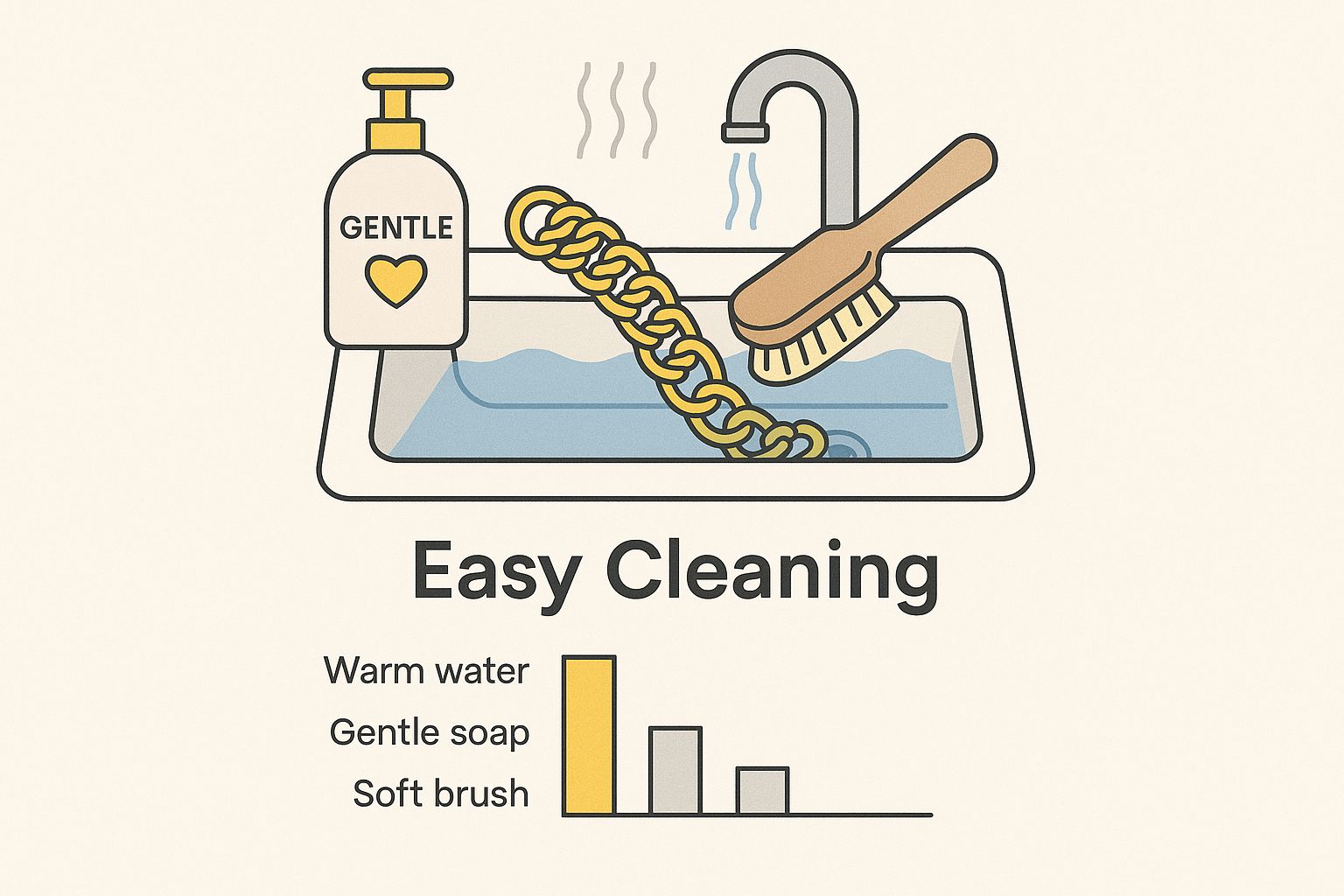
As you can see, it’s all about using basic, gentle household items to achieve a professional-looking result safely at home.
Preparing Your Cleaning Solution
First, grab a small bowl that's deep enough to completely submerge your jewellery and fill it with warm water. It's important to avoid using hot or boiling water, as sudden temperature shocks can actually damage certain gemstones or even weaken settings over time. Think of it as a comfortable bath for your gold, not a stressful ordeal.
Next, add just a few drops of a mild, phosphate-free washing-up liquid. Steer clear of harsh detergents or soaps with unknown chemicals, as they can be abrasive or leave a dulling film behind. A simple, gentle formula is all you need to cut through the oils without harming the gold. Give the water a gentle swirl to create a light, sudsy bath.
Key Takeaway: You're not trying to create a mountain of bubbles here. A tiny amount of gentle soap is more than enough to lift grease and dirt without leaving any residue.
The Soak and Gentle Scrub
Pop your gold pieces into the bowl and just let them soak for about 15-20 minutes. This is where most of the magic happens. The soak does the hard work for you, patiently loosening the layers of grime that have settled into all those tiny crevices and along the settings. It’s a vital step that makes the next part much, much easier.
After the soak, it’s time for a very gentle scrub. For this, you’ll need an exceptionally soft brush. The best choices are things like:
- A baby’s toothbrush with extra-soft bristles
- A small, soft-bristled makeup brush (an old eyeshadow one is perfect)
- A dedicated, soft jewellery cleaning brush
With your chosen brush, gently clean the piece. Focus on those tricky, hard-to-reach areas where dirt loves to hide—like behind the stone settings, inside the band of a ring, or between the links of a chain. Use soft, circular motions instead of aggressive scrubbing to avoid causing any fine scratches on the metal's surface.
The Final Rinse and Polish
Once you've finished brushing, rinse your jewellery well under warm, running water. Here's a pro tip: to stop a small item like an earring from accidentally disappearing down the drain, place your pieces in a small mesh tea strainer or colander for this step. Make sure every trace of soap is gone, as any leftover film will make the gold look dull.
Finally, the drying is just as important as the cleaning. Don't let your jewellery air-dry, as this can leave water spots. Instead, gently pat it dry with a soft, lint-free cloth. A microfibre cloth, a proper jeweller’s polishing cloth, or even an old, clean piece of cotton will do the job perfectly. Give it a final, gentle buff to bring out that brilliant, reflective shine and make it look as good as new.
Understanding How to Clean Gold of Different Karats
Not all gold is the same, and knowing its purity is the secret to cleaning it properly. That little number stamped on your jewellery—like 9k, 18k, or 24k—isn’t just about value; it's your guide to its care. Tweaking your cleaning method based on the karat is the best way to protect your pieces and keep them looking brilliant.
A piece’s karat tells you how much pure gold is in the mix. For instance, 24k gold is 99.9% pure, while 18k gold is 75% pure gold blended with other metals. Here in the UK, 9k gold is incredibly popular and contains 37.5% pure gold. Those other metals add strength but also change how the jewellery behaves over time.
Caring for Lower Karat Gold (like 9k and 14k)
Lower karat gold, especially the common 9k variety, has a higher amount of other metals like copper, silver, and zinc. This makes it much tougher and more resistant to scratches—perfect for a ring or bracelet you wear every day. The trade-off? Those same alloy metals are more likely to react with the air and moisture.
This means your 9k and 14k pieces might tarnish or discolour a bit faster than purer gold. It's a completely normal chemical process, not a sign of poor quality. To keep them looking their best, they just need a little more frequent attention.
- Polish Often: A gentle buff with a professional-grade polishing cloth every few weeks can lift away the early signs of tarnish before you even notice them.
- Clean Regularly: A simple soak in warm, soapy water is perfectly safe and works wonders. For items you wear daily, you might want to do this once a month to get rid of any build-up.
As UK jewellery experts often point out, lower karat gold like 9k tarnishes more easily but responds beautifully to regular polishing. For higher karats like 18k, the same gentle methods work perfectly. You can find more expert advice on caring for different gold types at HarpersBazaar.com to see what the pros recommend.
Cleaning Higher Karat Gold (like 18k and 24k)
As you move up to 18k and the exceptionally pure 24k gold, the metal gets much softer and takes on a richer, deeper yellow colour. Pure 24k gold is so malleable you could practically bend it with your fingers. This softness makes it extremely vulnerable to scratches, dents, and dings.
A Word of Caution: When cleaning high-karat gold, your main goal is to avoid abrasion. A heavy hand or the wrong tool can easily leave permanent marks on its delicate surface.
For these precious pieces, stick to the mildest methods only. A soapy water soak is ideal. If you must use a brush, choose one with the absolute softest bristles you can find—think more like a delicate makeup brush than a toothbrush. Be exceptionally gentle and never scrub. For 24k gold, a simple soak followed by a soft buff with a microfibre cloth is often the safest and most effective approach.
Gold Karat Cleaning Guide
To make things even clearer, here's a quick reference table. Think of it as a cheat sheet for keeping any piece of gold jewellery looking its absolute best, no matter its purity.
| Gold Karat | Key Characteristic | Recommended Cleaning Frequency | Special Considerations |
|---|---|---|---|
| 9k | Very durable, but prone to tarnishing due to high alloy content. | Monthly cleaning, bi-weekly polishing. | Responds well to a polishing cloth to restore shine. Handles soapy water well. |
| 14k | A good balance of durability and purity. Can still tarnish slowly. | Every 1-2 months. | Gentle soapy water soak is perfect. Check for tarnish regularly. |
| 18k | High gold content, softer than 9k/14k. More resistant to tarnish. | Every 2-3 months or as needed. | Be gentle to avoid scratches. A very soft brush is okay for crevices. |
| 24k | Pure gold. Extremely soft and easily scratched. Does not tarnish. | Clean only when visibly dirty. | Never scrub. Use only the softest cloth and a gentle soak. Avoid all abrasives. |
Ultimately, knowing your karats turns a chore into a simple, effective routine. By matching your method to the metal, you ensure your treasured pieces stay safe, sparkling, and ready to wear for years to come.
Cleaning Gold Jewellery with Gemstones or Pearls
Adding gemstones or pearls to a piece of gold jewellery instantly elevates its beauty, but it also completely changes the cleaning rules. While solid gold itself is pretty tough, many of the beautiful stones set within it are surprisingly delicate.
What works wonders for a simple gold chain could permanently ruin a pearl necklace or an opal ring. It's not a one-size-fits-all situation.
The absolute first step is to know what stone you're dealing with before you even think about cleaning. Different gems have wildly different levels of hardness and porosity, which dictates how they’ll react to water, let alone chemicals. Getting this wrong is one of the quickest ways to ruin a treasured piece, so it really pays to be cautious.
Handling Porous and Delicate Stones
Some of the most captivating gemstones are also the most fragile. Think of pearls, opals, emeralds, turquoise, and coral. These are what we call porous stones, which means they can actually absorb liquids. Soaking them in water, especially soapy water, is a recipe for disaster—it can cause them to discolour, turn cloudy, or even crack.
For these types of stones, you have to avoid soaking them completely. Your cleaning approach needs to be much, much simpler:
- A Soft, Damp Cloth: Take a microfibre cloth and lightly dampen it with clean, lukewarm water. Gently wipe the stone and the gold around it to lift away any surface dirt and oils.
- Dry Immediately: As soon as you've wiped it, use a separate dry, soft cloth to pat the piece completely dry. You don't want to leave any moisture sitting on the stone.
Honestly, this gentle wipe-down is often all that's needed to restore the lustre of a pearl or the fire of an opal without causing any harm. It's a classic less-is-more approach that puts the safety of the stone first.
Crucial Safety Tip: Never, ever use ammonia, harsh detergents, or ultrasonic cleaners on jewellery with porous or soft stones. The chemicals and intense vibrations can cause irreversible damage, from discolouration right through to shattering the gem.
Safely Cleaning Hard Gemstones
On the other end of the spectrum, you have the tough, durable gemstones. Stones like diamonds, sapphires, and rubies are much less porous and significantly harder, which makes them far more resilient. For gold jewellery set with these hard stones, you can confidently go ahead and use the gentle soap-and-water method.
Even so, you still need to be careful, especially around the settings. The goal is to clean the piece without accidentally loosening a precious stone. When you're using a soft brush, use gentle, precise movements around the claws or prongs holding the gem in place. Scrubbing too aggressively can bend these delicate metal parts over time, which could compromise the security of the setting.
After a quick soak and gentle brushing, pay extra attention when you rinse. You need to make sure all the soap residue is washed away, especially from underneath the stone. Trapped soap film creates a cloudy appearance behind the gem, dulling its sparkle just as much as dirt can. A thorough rinse and careful drying will ensure both the gold and the gemstone shine brilliantly. By tailoring your technique to the specific stone, you can keep your most ornate pieces looking spectacular.
Common Cleaning Mistakes You Need to Avoid
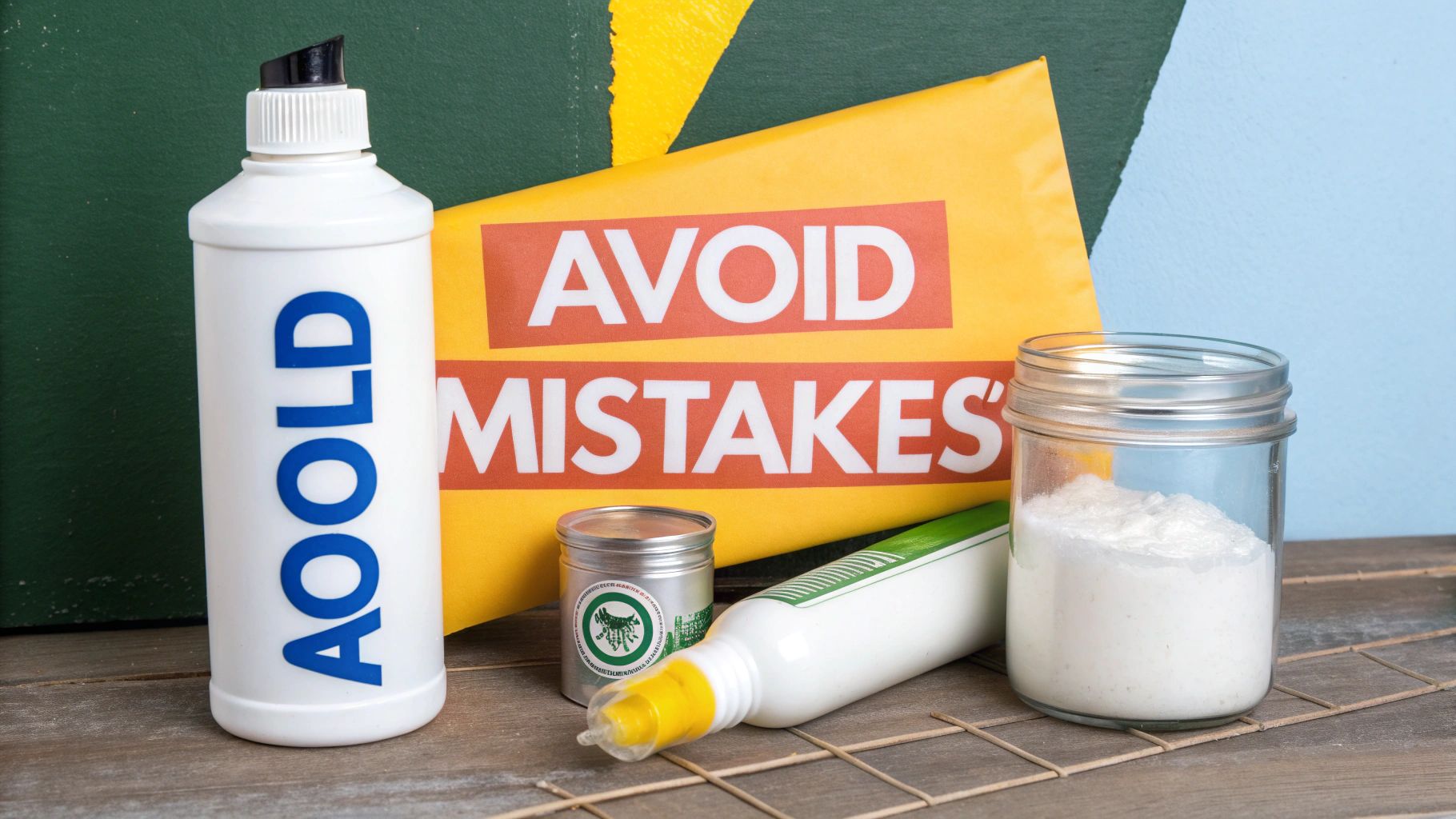
Knowing how to clean gold jewellery is just one half of the story. Knowing what not to do is, arguably, even more important. A simple mistake with the wrong household product can cause irreversible damage, turning a quick clean into a costly repair.
Think of this as your essential guide to protecting your treasured pieces from accidental harm. Many common household cleaners that seem harmless are incredibly destructive to gold. The worst offenders contain chlorine, like bleach. When chlorine meets gold, it can weaken the metal’s structure and lead to stress corrosion cracking, especially around delicate solder points and prongs.
This means a single exposure while you’re cleaning the kitchen could permanently compromise your ring.
Abrasives Are Not Your Friend
It can be tempting to reach for something with a bit of grit to scrub away stubborn grime, but this is a critical error. Products like toothpaste and baking soda are far too abrasive for the soft surface of gold. They act like fine sandpaper, creating thousands of microscopic scratches that will completely strip away the metal's lustrous finish, leaving it looking dull and hazy.
Imagine using a kitchen scourer on a pair of delicate sunglasses—the result is the same. I once saw a beautiful 18k gold heirloom ring that a client had tried to brighten with baking soda. It came into our workshop covered in a web of fine scratches, and it took a significant amount of professional polishing to restore its shine.
Key Takeaway: If a substance feels gritty between your fingers, it has no place near your gold. Stick to liquids and ultra-soft cloths to avoid permanently scratching the metal.
The Risks of Home Ultrasonic Cleaners
While professional ultrasonic cleaners are fantastic tools in the hands of a jeweller, the home-use versions come with significant risks. These machines use high-frequency sound waves to create tiny vibrations in a liquid bath, which can be very effective at dislodging dirt from hard-to-reach places.
However, those same powerful vibrations can be disastrous for certain types of jewellery.
- Fragile Settings: The vibrations can easily loosen the prongs holding a gemstone in place, causing it to fall out. We see this all too often.
- Porous Gemstones: Stones like opals, pearls, or emeralds are delicate and can be fractured or damaged by the intense vibrations.
- Treated Stones: Many gemstones are treated with oils or resins to enhance their appearance, and an ultrasonic cleaner can strip these vital treatments away, dulling the stone.
Without an expert's knowledge of stone security and gemstone properties, using a home ultrasonic cleaner is a gamble. Sticking to safer, manual methods is always the smarter choice for protecting your investment.
When It’s Time to See a Professional Jeweller
Knowing how to clean your gold at home is fantastic for day-to-day upkeep, but there are times when you really need an expert’s touch. Think of it like servicing your car; you can handle the basics, but the deep work is best left to a mechanic. A visit to a jeweller is crucial when you’re dealing with issues that a simple soak and scrub just won't resolve.
For example, that beautiful vintage filigree ring with deeply embedded grime needs more than a soft brush. It calls for professional ultrasonic cleaning to safely dislodge dirt without damaging the delicate metalwork. Likewise, if your gold has noticeable scratches or a dull, hazy finish from years of love and wear, only a professional polish will restore that original mirror-like shine. Trying to buff out scratches yourself can easily cause more harm than good.
Beyond a Simple Clean
A trip to the jeweller isn't just about making your pieces look good; it's a vital security check. In fact, an annual professional inspection is one of the best things you can do to protect your investment.
During a professional clean, a jeweller will do much more than you can at home:
- Check for loose stones by carefully examining every prong and setting.
- Inspect clasps and links for signs of wear and tear before they fail.
- Identify potential issues that are invisible to the naked eye.
"Think of an annual professional clean as a health check-up for your most treasured pieces. It’s preventative care that catches small problems before they become heartbreaking losses."
This proactive approach is becoming more and more common. The UK jewellery care market is seeing steady growth, partly because people are demanding high-quality professional services to protect their valuable items. Projections show the industry expanding by around 3% annually, driven by high standards for both products and service. You can discover more insights about the growing professional jewellery care market on Fact.MR.
So, when your at-home methods just aren't cutting it, entrusting your pieces to a professional isn't just a good idea—it's a necessary step.
Common Gold Cleaning Questions
Even with a solid cleaning routine, you’re bound to have a few questions. Getting the right answers means you can look after your gold with total confidence, no guesswork needed.
How Often Should I Clean My Everyday Jewellery?
For pieces you never take off, like a wedding band, a quick once-over with a polishing cloth every week is a great habit to get into. This lifts the daily grime before it builds up.
Then, every month or two, give it a proper deep clean with warm, soapy water. This will dissolve any stubborn residue from hand creams, oils, and life in general. For jewellery you wear less frequently, a deep clean every six months is usually more than enough to keep it sparkling.
Is It Safe to Use Boiling Water on Gold?
Absolutely not. You should never use boiling water.
While the gold itself can take the heat, the sudden, extreme temperature change can easily crack gemstones – even diamonds. It can also melt or weaken any glue used to secure stones in their settings. Always, always stick to warm water for a safe and effective clean.
A quick word on commercial cleaning solutions: while some are perfectly fine, you have to read the label carefully. Many contain ammonia or other chemicals that can permanently damage porous gemstones like pearls, opals, and turquoise. When in doubt, our simple soap and water method is always the safest bet.
For a professional clean that not only restores that showroom shine but also includes a check for loose stones and general wear, it’s best to trust the experts. At Opulence Jewellery Services, our Hatton Garden workshop provides meticulous, same-day cleaning and repairs. Bring your cherished pieces back to life by visiting us today.
